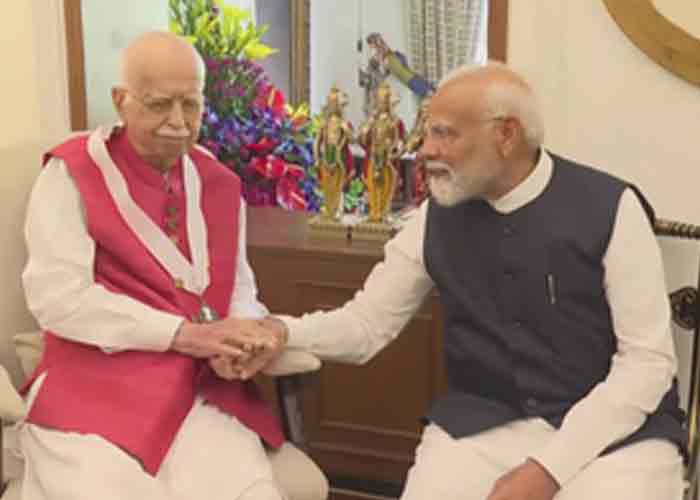The 96-year-old former Deputy Prime Minister Lal Krishna Advani was awarded the Bharat Ratna award on Sunday, marking the beginning of a magnificent chapter in his life and times. President Droupadi Murmu, Vice President Jagdeep Dhankhar, Prime Minister Narendra Modi, former Vice President M. Venkaiah Naidu, and a plethora of other dignitaries were present when the gates of 30 Prithviraj Road in Delhi opened.
Coincidentally, on Easter Sunday, 1980, the day the Bharatiya Janata Party (BJP) was founded, Advani received the highest civilian award in the country at his official residence.
People who were acquainted with Advani frequently heard a fascinating story.
On April 4, 1980, Good Friday, the day Jesus was crucified, the Jan Sangh, which had merged with the Janata Party in 1976, broke away from it due to arguments over “dual membership,” or maintaining alignment with the RSS while being a member of the Janata Party. And on April 6, 1980, Easter Sunday, the day commemorating Jesus’ resurrection, it emerged in a new guise, rebranded as the Bharatiya Janata Party.
Advani was one of the BJP’s founders, along with Atal Bihari Vajpayee. And he never failed to see its symbolic meaning.
Social background, caste, and geography have all historically been used as stigmas against India and Indian politics. Additionally, Advani’s story defies many stereotypes and is distinct for both the BJP and modern Indian political history.
Advani’s long political career has been remarkable. He went from being a non-Hindi speaking Sindhi student at the Christian missionary St. Patrick’s School in Karachi to choosing the RSS, moving to India from Pakistan after the Partition, and steadily moving up the organisational ladder. In 1990, he led the largest public mobilisation and debate in Independent India.
The archetypal charioteer not only embarked on his Yatra to build a “Bhavya” Ram temple at the purported Ram Janmabhoomi site in Ayodhya, but he also used terms like “pseudo-secularism,” “appeasement politics,” “cultural nationalism,” and drawing a distinction between “Swaraj” (independence) and “Suraj” (good governance), among other things, to criticise the political and purportedly intellectual establishment.
It is noteworthy that when he was a young party leader, Narendra Modi organised the first leg of Advani’s Rath Yatra from Somnath to Ayodhya, which led to its success right from the start. Modi served as prime minister for ten years.
When Advani was detained by Lalu Prasad a month after the Yatra arrived in Sitamarhi, Bihar, and was ready to cross into Uttar Pradesh, Narendra Modi was also with him. The BJP overthrew the V.P. Singh government at the centre as a result of the arrest.
It indicated two things.
First, a unique backroom deal between two ideological extremes, the Left Front led by CPI (M) and the BJP, coming together to prop up a collapsing coalition government.
Second, the course of events that followed compelled the 1992 parliamentary elections to be held in less than three years, favouring the BJP.
Only two Lok Sabha seats were won by the BJP in the first elections held in 1984 following the assassination of then-prime minister Indira Gandhi, compared to the Congress’s more than 400 seats.
Many would say to him, “Advani ji, dukan badh kar do (shut the shop).”
However, the story of the Vajpayee-Advani team’s incredible fortitude, diligence, creativity, and capacity for reinvention is what the BJP rode on to shatter social and geographic barriers and create new ones.
In 1989, the BJP soared to 86 seats under Advani’s leadership as the longest-serving party President. The total increased to 121 seats in the 1992 elections.
Promotion
Following the Ram Rath Yatra, Advani reached the pinnacle of public and Sangh Parivar acceptance as the BJP’s most palatable face. However, he abruptly declared in 1995 at a party convention in Mumbai that Vajpayee, not he, should be Prime Minister should the BJP secure the necessary number of seats to form the government at the Centre.
The workers and party leaders were completely taken aback by the announcement.
The BJP achieved a historic milestone in the 1996 elections when it secured 161 seats, making it the only major party. At this time, Vajpayee was appointed Prime Minister and Advani was named Home Minister in the first BJP-led government to be formed at the Centre. But the administration was only in place for 13 days.
By the time of the subsequent elections, Advani had gone on the hunt for allies, leading to the formation of the National Democratic Alliance, which was led by the BJP.
In 1998, with the NDA 1.0 taking power for a longer period of time, the BJP grew to 182 members in the Lok Sabha. History is what’s left.
Advani and his supporters couldn’t have come at a more auspicious time: Prime Minister Modi’s announcement of his Bharat Ratna shortly before the opening of the Ram Temple in Ayodhya, the realisation of the ‘Mandir Wahin Banayenge’ dream, and the award given to him on this historic day, when 44 years ago he was a key figure in the formation of the BJP.






